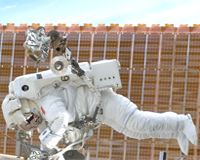
In a familiar high-school chemistry demonstration, an instructor first uses electricity to split liquid water into its constituent gases, hydrogen and oxygen. Then, by combining the two gases and igniting them with a spark, the instructor changes the gases back into water with a loud pop.
Scientists at the University of Illinois have discovered a new way to make water, and without the pop. Not only can they make water from unlikely starting materials, such as alcohols, their work could also lead to better catalysts and less expensive fuel cells.
"We found that unconventional metal hydrides can be used for a chemical process called oxygen reduction, which is an essential part of the process of making water," said Zachariah Heiden, a doctoral student and lead author of a paper accepted for publication in the Journal of the American Chemical Society, and posted on its Web site.
A water molecule (formally known as dihydrogen monoxide) is composed of two hydrogen atoms and one oxygen atom. But you can't simply take two hydrogen atoms and stick them onto an oxygen atom. The actual reaction to make water is a bit more complicated: 2H2 + O2 = 2H2O + Energy.
In English, the equation says: To produce two molecules of water (H2O), two molecules of diatomic hydrogen (H2) must be combined with one molecule of diatomic oxygen (O2). Energy will be released in the process.
"This reaction (2H2 + O2 = 2H2O + Energy) has been known for two centuries, but until now no one has made it work in a homogeneous solution," said Thomas Rauchfuss, a U. of I. professor of chemistry and the paper's corresponding author.
The well-known reaction also describes what happens inside a hydrogen fuel cell.
In a typical fuel cell, the diatomic hydrogen gas enters one side of the cell, diatomic oxygen gas enters the other side. The hydrogen molecules lose their electrons and become positively charged through a process called oxidation, while the oxygen molecules gain four electrons and become negatively charged through a process called reduction. The negatively charged oxygen ions combine with positively charged hydrogen ions to form water and release electrical energy.
The "difficult side" of the fuel cell is the oxygen reduction reaction, not the hydrogen oxidation reaction, Rauchfuss said. "We found, however, that new catalysts for oxygen reduction could also lead to new chemical means for hydrogen oxidation."
Rauchfuss and Heiden recently investigated a relatively new generation of transfer hydrogenation catalysts for use as unconventional metal hydrides for oxygen reduction.
In their JACS paper, the researchers focus exclusively on the oxidative reactivity of iridium-based transfer hydogenation catalysts in a homogenous, non-aqueous solution. They found the iridium complex effects both the oxidation of alcohols, and the reduction of the oxygen.
"Most compounds react with either hydrogen or oxygen, but this catalyst reacts with both," Heiden said. "It reacts with hydrogen to form a hydride, and then reacts with oxygen to make water; and it does this in a homogeneous, non-aqueous solvent."
The new catalysts could lead to eventual development of more efficient hydrogen fuel cells, substantially lowering their cost, Heiden said.
The work was funded by the U.S. Department of Energy.







